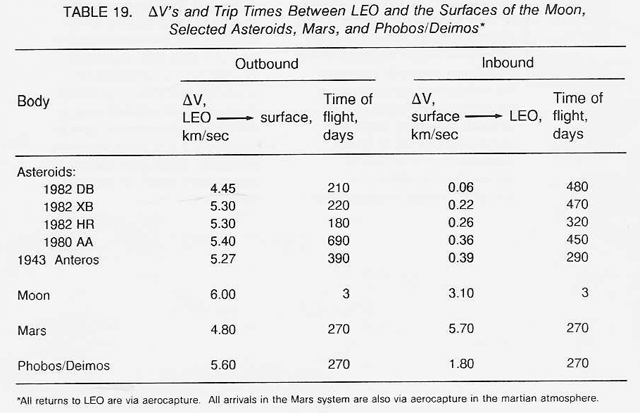
The best possible target would be a body that can be reached simply by achieving escape velocity from Earth and which is about to collide with the Earth (so that no return propulsion is required). The round trip delta V from LEO for this unattainably ideal case is about 3.4 km/sec. A reasonable estimate of the number of near-Earth asteroids with radii of 1 km or more yet to be discovered is 1000 to 4000. Estimating that 10 percent of them will be in accessible orbits (round-trip total delta V < 6 km/sec), some 100 to 400 1-kilometer-size bodies should be available for exploitation. The number of bodies with radii of 100 m to 1 km is probably several hundred times as large.
The martian satellites Phobos and Deimos are less attractive in terms of the energy needed to reach them than the near-Earth asteroids but still more accessible for exploitation than the surface of the Moon. Like the Moon, Phobos and Deimos apparently have a regolith and lack an atmosphere. Three independent sources of information-thermal inertia measurements and photographs made from Mariner 9 and Viking and ground-based radar measurements-indicate the presence of a lunar-like regolith that is tens of meters deep in some places. Measurements of the densities of Phobos and Deimos, their albedo (dark), and their spectral reflectance are similar to those for carbonaceous chondrite meteorites and the possibly organic-rich D- and P-type asteroids. However, ground-based photometry of Deimos made during the 1988 opposition of Mars shows no 3-micron water band in its spectrum, and data from the Soviet spacecraft Phobos 2 must be thermally modeled before these images and spectra can provide information on the presence of water on Phobos. Thus, to associate the composition of Phobos and Deimos with any meteorite type would require ,a mission capable of taking a chemical inventory of these satellites.*
The delta V requirements for the outbound (LEO to surface of body) and inbound (surface of body to LEO) legs and the trip times for asteroidal, lunar I and martian trajectories are compared in table 19. Note that the Mars system is mainly useful for supplying resources to support Mars endeavors. However, return of martian satellite materials to LEO is somewhat more attractive energetically than return of lunar materials to LEO (return delta V's about 40% lower).

Asteroids as Targets for Resource Exploitation
Although both meteoriticists and asteroid spectroscopists are puzzled over the lack of correspondence between types of meteorites as analyzed in the laboratory and types of asteroids as measured by remote sensing of their surface mineralogy, there are indications in these spectral reflectance data that some of the near-Earth asteroids resemble the volatile-rich carbonaceous chondrites. So useful would volatiles, including water and carbon dioxide, be in space settlements that additional support for the effort to find and characterize more of these asteroids seems warranted. (See the preceding paper by Mike Gaffey.)
Though we have no spectral typing of the most accessible asteroid, 1982 DB, the fact that a round trip to it or one of several other near- Earth asteroids requires less energy than a round trip to the surface of the Moon is another reason to keep looking for an asteroid that is both accessible and of a desirable composition. Should such a candidate for resource exploitation be found, then we would want to send a reconnaissance mission to it to determine if it is really a mining prospect. (See Rich Gertsch's subsequent paper on asteroid mining.)
*Lucy McFadden, 1989, in vol. VI of Exploration Studies Technical Report, published by Office of Exploration, Johnson Space Center, NASA TM-4170. pp. 2-6 & 2-7.
Next